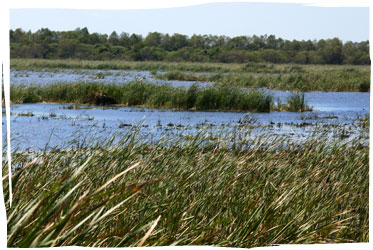The Problem with Reclamation

Though this grassy wetland may seem like a healthy habitat, it lacks diversity. Even the best-case scenarios of reclamation fail to provide the variety of habitats needed to sustain truly healthy ecosystems.
Restoring the land after strip mining is a good idea. But setting standards and measuring the results of reclamation is often a disputed process. We know that the land and water can never be what it once was. Phosphate mining companies say that mining is a temporary impact. That is true if impacts are measured in geologic time. It will take hundreds of years, if ever, for strip-mined areas to recover. Some experts say these areas will never be the same again.
We also know that the phosphate industry, along with the phosphate, will be long gone before the next century arrives. But, their legacy will be with Florida for generations to come. It is our job to ensure that future generations will not have to pay environmentally or economically for what is allowed today.

Dr. Tom Fraser looks for fish in a reclaimed wetland. The only thing found is minnows.
Rules for reclamation haven't been reviewed in nearly 20 years. It's time to take a real look at reclamation processes and procedures to see if they still represent the best science and technology. In its own Cumulative Impact Study, the Florida Department of Environmental Protection concluded that Floridians have continued to lose wetlands and streams—even after regulations were enacted. Those who challenge the phosphate permits say that it is largely due to failed reclamation.
Habitat Restoration—Habitat restoration is supposed to provide sufficient vegetation to bring back some of the functions of the natural land. Birds, fish, amphibians, mammals, reptiles and other wildlife all require habitat for food and shelter and are affected by mining activities. To restore habitat requires replanting the trees, bushes and other vegetation that provide food as well as protection from predators. For restoration to be successful, water flows for both the mined property and the communities downstream must be returned to pre-mining condition. It's a complicated process to recreate nature. Some wildlife species need different habitats at various life stages. If even one of those habitats is missing, the species cannot survive.
Water Flows—Mosaic phosphate company says that they've done a good job on water conservation and now recycle 98 percent of the water they use. They have made strides in this area. But some environmentalists question that statistic and want to know why mining companies aren't operating on a "water budget." If mines and chemical processing plants were required to operate on a water budget that takes into consideration pumping and runoff, the figures for recycling might be different. More important, regulators would have a much better idea of exactly how much water is really being used and how much is lost. The bottom line: reclamation standards could be set based on real, on-site water flows.
Clay Settling Ponds—No matter what else is done, mining activities change the landform and leave clay settling ponds, which dominate the landscape. While the engineering of clay settling ponds may have improved over time, they are still an environmental issue. They're full of waste that can be devastating if a leak or spill occurs. Because they "seal" the surface and don't allow water to seep underground or block the natural movement of groundwater, the ponds have a long-term negative effect on water supplies. This is especially bad for wetlands. Normally, wetlands act as natural recharge to the aquifer and as reservoirs. But a wetland on a reclaimed mine is of no real value. When about 40 percent of mined land becomes settling ponds, the problem is clear: water flows disrupted and the threat of spills for decades to come.
Reclamation is supposed to be part of the reasonable assurance we're given that the environment will be restored. But if the rules haven't changed in almost 20 years, how can we be assured that they represent the "best technology" or the best procedure for managing water flows, clay ponds and wildlife and habitat restoration? Reclamation rules need to be held up to the bright light of public oversight, comment and input. When reclamation rules pass this test, we will have reasonable assurance.